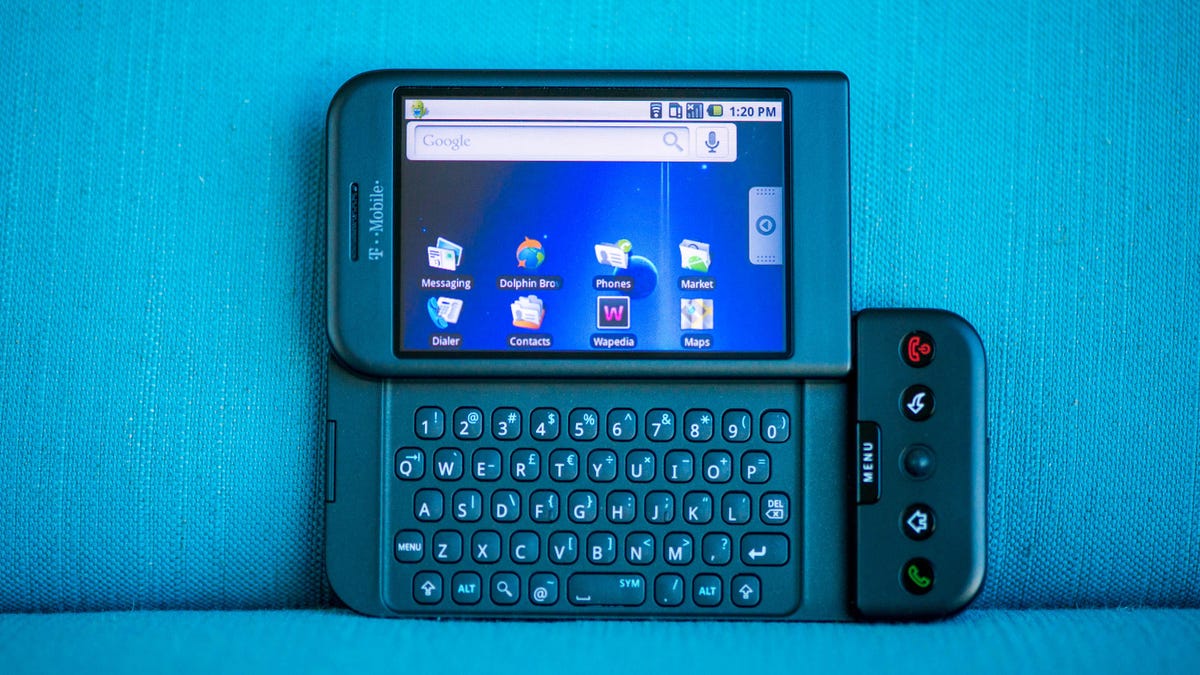
The world's first Android phone, the HTC Dream, known in the US as the T-Mobile G1, celebrates the 15th anniversary of its product announcement on Sept. 23, 2023. Compared with the giant phones of today, the G1 looks like it came from another planet. Enjoy a walk down memory lane with photos shot for the G1's 10th birthday.
Read: Before Google's Android Ruled the World, It Had to Get Radical. I Had A Front-Row Seat
This photo gallery was originally published Sept. 21, 2018. It has been updated for the T-Mobile G1's 15th anniversary.
The first version of Android wasn't known by a sweet dessert name -- that didn't come until Android 1.5 Cupcake in 2009.
Version 9, Android Pie, was the last dessert-named version. Android Q, known in its live form as Android 10, quit the tradition. Google's mobile OS is sophisticated and mature. Part of what made the Android of the G1 so special was exactly how new it was. This baby Android lacked the identity we know so well today.
The T-Mobile G1 stood 4.6 inches tall, with a 3.2-inch screen.
There was a trackball in the center for navigation, plenty of physical buttons and a slide-out landscape QWERTY keyboard.
It looked like this when you made a call. And yes, people in 2008 made a lot more calls.
The landscape keyboard meant you had to turn the phone sideways every time you wanted to type -- the original G1 didn't launch with a virtual keyboard.
The keys were flat and well spaced. Editors differed in their opinion of the G1 as a typing machine.
Android phones have always had app trays, a separate place to index all your programs. This differed from the first-generation iPhone launched a year before the G1, which, like today, lays all the icons on the home screen.
Take a look at the pixels. The G1's screen 480x320-pixel resolution meant a pixel density of 180.3. Today, high-end phones have a pixel density in the 500s.
Android phones supported folders and GPS from the very beginning.
There was also an Android Market at launch.
The phone's chin was a major characteristic. It's supposed to ergonomically curve to meet your chin, but some of us found it unsightly and thought it got in the way of typing.
The G1, left, compared to the Galaxy Note 8.
You can really see the chin stick out.
While the iPhone had one major navigation button, the G1 was full of them.
From left to right, you can see the call button, home button, trackball, menu button, back button and power button.
There was also a dedicated camera shutter button on the side.
Sliding out the keyboard was half the fun. Here's what the track looked like on the G1's rear.
Remember when flaps used to cover ports?
Look around the edges and you can see how the cover didn't always fit tightly.
Unlike most other phones of the day, HTC didn't give the G1 a headphone jack. This Micro-USB port was all it had.
A 3.2-megapixel camera on the back took better photos than Apple's original iPhone.
Check out even more photos of the T-Mobile G1 below.
The T-Mobile G1, side by side with the Google Pixel 2. In 2023, 15 years after the T-Mobile G1 was announced, Google is set to release the Pixel 8.
Ready to reminisce? Revisit our original T-Mobile G1 review, and find out how HTC, Google and T-Mobile got Android off to a crazy start.
Read about the secret sauce that made Android the most dominant phone on the planet today.

